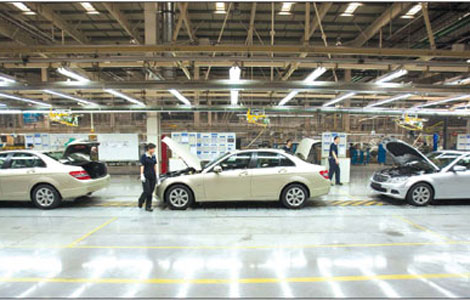Hot spots move to smaller cities
Updated: 2011-03-04 10:24
By Yang Qingsong (China Daily European Weekly)
China's retail industry has grown rapidly during the past several years. Average sales for the top 100 chain department stores grew by 22 percent from 2006 to 2010. Growth of the industry in second- and third-tier cities has been faster than in first-tier cities such as Beijing and Shanghai.
In 2009, there were only 47 top 100 chain department stores headquartered in Beijing, Shanghai, Guangzhou and Shenzhen. Sales for the top 100 chain department stores in second- and third-tier cities has also grown faster than in first-tier cities.
A report recently found that the average sales growth of department stores and supermarkets was 5.3 percent in first-tier cities, but was 19.3 percent in second- and third-tier cities.
It also found that the outlet growth of department stores and supermarkets was 7.2 percent in first-tier cities, but 14.7 percent in second- and third-tier cities.
Among the 24 chain department stores whose sales grew by more than 20 percent in 2009, only nine are headquartered in Beijing, Shanghai, Guangzhou and Shenzhen, accounting for 37 percent. Others are headquartered in second- and third-tier cities.
Among the 36 department stores whose sales growth was lower than 10 percent, 24 are headquartered in Beijing, Shanghai, Guangzhou and Shenzhen, accounting for 67 percent.
There are many reasons that the growth of retail sales in the second- and third-tier cities are faster than that in first-tier cities.
First is urbanization.
One of the major problems existing in China's urbanization is "metropolitan fever". Big cities are densely populated, creating traffic jams and housing shortages.
Beijing has recently carried out policies to limit purchases of housing and automobiles. Other big cities may follow suit. This will reduce population flow to big cities.
While the urbanization process in first-tier cities is slowing down, the population in second- and third-tier cities will increase rapidly.
China's urbanization rate may soon reach 50 percent, and possibly 60 percent in 2020. The growth potential will be mainly in second- and third-tier cities.
Second, the purchasing power in second- and third-tier cities will grow faster than that in first-tier cities.
Consumption in first-tier cities has grown exponentially during the past few years. Such rapid growth cannot be maintained in the future. But residents in second- and third-tier cites are just beginning to think like consumers. There is huge potential.
Per capita disposable income of China's urban dwellers in 2010 is 19,109 yuan (2,110.7 euros), up 7.8 percent from the previous year, while the figure is 5,919 yuan for the rural population, up 10.9 percent from the previous year. Income growth of people in second- and third-tier cites is higher than that of people in first-tier cities.
The increase in incomes has set the foundation for the retail industry to grow in second- and third-tier cities. Many international high-end brands have set up stores in second- and third-tier cities in the past year, a sign that consumption power is growing in these regions.
Third, development opportunities for the retail industry is relatively better in second- and third-tier cities.
The first-tier cities have more business facilities and companies. They are the main target market for foreign retailers.
Now every sector of retailing has saturated or tends to saturate in first-tier cities because of competition, increasing rent and labor costs.
In second- and third-tier cities, however, competition is more moderate and the costs to rent for a business is much lower than in first-tier cities. The level of incomes for employees is much lower than that of first-tier cities. There is growing stability among company staff. Therefore retailers can enjoy a looser management environment.
In the past two years, many supermarkets, department stores and specialty stores previously targeting first-tier cities have started to open their chain stores in second- and third-tier cites (even in county-level cites), and have achieved good sales performances.
Many fast growing regional companies with standardized management and good sales performances have emerged in second- and third-tier cities, such as Jiajiayue Supermarket Shandong, Better-life Commercial Chain Share Hunan, SPAR Guangdong. They started from third-tier cities, gained large market share in neighboring markets, and have established good reputations.
Their tales of success is nothing new: Many excellent trans-regional and cross-country retailers started from small cities.
The author is deputy secretary-general of China Chain Store & Franchise Association.
E-paper

Factory fever
Despite auto manufacturing bubble scare, car giants gear up expansion of factories.
Dressed for success
Fabric of change
High spirits
Specials

Earthquake Hits Japan
A massive 8.8 magnitude quake hit the northeast coast of Japan on March 11,2011.

NPC & CPPCC sessions
Lawmakers and political advisers gather in Beijing to discuss major issues.

Slide: Japan quake
Devastating earthquake and tsunami left millions without water, electricity, homes or heat.
